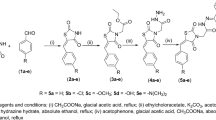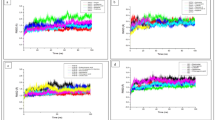Abstract
Type 2 diabetes mellitus (T2DM) has become a serious public health problem both in our country and worldwide, being the most prevalent type of diabetes. The combined use of drugs in the treatment of T2DM leads to serious side effects, including gastrointestinal problems, liver toxicity, hypoglycemia, and treatment costs. Hence, there has been a growing emphasis on drugs that demonstrate dual interactions. Several studies have suggested that dual-target agents for peroxisome proliferator-activated receptor-γ (PPAR-γ) and alpha-glucosidase (α-glucosidase) could be a potent approach for treating patients with diabetes. We aim to develop new antidiabetic agents that target PPAR-γ and α-glucosidase enzymes using molecular modeling techniques. These compounds show dual interactions, are more effective, and have fewer side effects. The molecular docking method was employed to investigate the enzyme-ligand interaction mechanisms of 159 newly designed compounds with target enzymes. Additionally, we evaluated the ADME properties and pharmacokinetic suitability of these compounds based on Lipinski and Veber’s rules. Compound 70, which exhibited favorable ADME properties, demonstrated more effective binding energy with both PPAR-γ and α-glucosidase enzymes (-12,16 kcal/mol, -10.07 kcal/mol) compared to the reference compounds of Acetohexamide (-9.31 kcal/mol, -7.48 kcal/mol) and Glibenclamide (-11.12 kcal/mol, -8.66 kcal/mol). Further, analyses of MM/PBSA binding free energy and molecular dynamics (MD) simulations were conducted for target enzymes with compound 70, which exhibited the most favorable binding affinities with both enzymes. Based on this information, our study aims to contribute to the development of new dual-target antidiabetic agents with improved efficacy, reduced side effects, and enhanced reliability for diabetes treatment.






Similar content being viewed by others
References
Ogurtsova K, Guariguata L, Barengo NC, Ruiz PL, Sacre JW, Karuranga S et al (2022) IDF diabetes Atlas: Global estimates of undiagnosed diabetes in adults for 2021. Diabetes Res Clin Pract 183:109118
Intenational Diabetes Federation (IDF) (2022) Intenational diabetes federation (IDF). Available from: https://diabetesatlas.org/. Accessed 13 Apr 2024
Ahmad E, Lim S, Lamptey R, Webb DR, Davies MJ (2022) Type 2 diabetes. Lancet 400(10365):1803–1820
Dhameja M, Gupta P (2019) Synthetic heterocyclic candidates as promising alpha-glucosidase inhibitors: An overview. Eur J Med Chem 176:343–377
Tan SY, Mei Wong JL, Sim YJ, Wong SS, Mohamed Elhassan SA, Tan SH et al (2019) Type 1 and 2 diabetes mellitus: A review on current treatment approach and gene therapy as potential intervention. Diabetes Metab Syndr 13(1):364–372
Artasensi A, Pedretti A, Vistoli G, Fumagalli L (2020) Type 2 Diabetes Mellitus: A Review of Multi-Target Drugs. Molecules 25(8):1987
Chaudhury A, Duvoor C, Reddy Dendi VS, Kraleti S, Chada A, Ravilla R et al (2017) Clinical Review of Antidiabetic Drugs: Implications for Type 2 Diabetes Mellitus Management. Front Endocrinol (Lausanne) 8:6
Janani C, RanjithaKumari BD (2015) PPAR gamma gene–a review. Diabetes Metab Syndr 9(1):46–50
Nanjan MJ, Mohammed M, Prashantha Kumar BR, Chandrasekar MJN (2018) Thiazolidinediones as antidiabetic agents: A critical review. Bioorg Chem 77:548–567
Jiang H, Zhou XE, Shi J, Zhou Z, Zhao G, Zhang X et al (2020) Identification and structural insight of an effective PPARgamma modulator with improved therapeutic index for anti-diabetic drug discovery. Chem Sci 11(8):2260–2268
Ballav S, Biswas B, Sahu VK, Ranjan A, Basu S (2022) PPAR-gamma Partial Agonists in Disease-Fate Decision with Special Reference to Cancer. Cells 11(20):3215
Nolte RT, Wisely GB, Westin S, Cobb JE, Lambert MH, Kurokawa R et al (1998) Ligand binding and co-activator assembly of the peroxisome proliferator-activated receptor-gamma. Nature 395(6698):137–143
Gangadhariah M, Pardhi T, Ravilla J, Chandra S, Singh SA (2022) Citrus nutraceutical eriocitrin and its metabolites are partial agonists of peroxisome proliferator-activated receptor gamma (PPARgamma): a molecular docking and molecular dynamics study. J Biomol Struct Dyn 41(21):11373–11393
Singh VP, Dowarah J, Marak BN, Tewari AK (2021) Design, synthesis, in silico analysis with PPAR-γ receptor and study of non-covalent interactions in unsymmetrical heterocyclic/phenyl fleximer. J Chin Chem Soc 68(1):150–158
Rajapaksha H, Bhatia H, Wegener K, Petrovsky N, Bruning JB (2017) X-ray crystal structure of rivoglitazone bound to PPARgamma and PPAR subtype selectivity of TZDs. Biochim Biophys Acta Gen Subj 1861(8):1981–1991
van de Laar FA (2008) Alpha-glucosidase inhibitors in the early treatment of type 2 diabetes. Vasc Health Risk Manag 4(6):1189–1195
Mehmood R, Mughal EU, Elkaeed EB, Obaid RJ, Nazir Y, Al-Ghulikah HA et al (2022) Synthesis of Novel 2,3-Dihydro-1,5-Benzothiazepines as alpha-Glucosidase Inhibitors: In Vitro, In Vivo, Kinetic, SAR, Molecular Docking, and QSAR Studies. ACS Omega 7(34):30215–32
Hedrington MS, Davis SN (2019) Considerations when using alpha-glucosidase inhibitors in the treatment of type 2 diabetes. Expert Opin Pharmacother 20(18):2229–2235
Hossain U, Das AK, Ghosh S, Sil PC (2020) An overview on the role of bioactive alpha-glucosidase inhibitors in ameliorating diabetic complications. Food Chem Toxicol 145:111738
Moreland RJ, Jin X, Zhang XK, Decker RW, Albee KL, Lee KL et al (2005) Lysosomal acid alpha-glucosidase consists of four different peptides processed from a single chain precursor. J Biol Chem 280(8):6780–6791
Nkoana JK, Maluleka MM, Mphahlele MJ, Mampa RM, Choong YS (2022) Synthesis, Conformational Analysis and Evaluation of the 2-aryl-4-(4-bromo-2-hydroxyphenyl)benzo[1,5]thiazepines as Potential alpha-Glucosidase and/or alpha-Amylase Inhibitors. Molecules 27(20):6935
Roig-Zamboni V, Cobucci-Ponzano B, Iacono R, Ferrara MC, Germany S, Bourne Y et al (2017) Structure of human lysosomal acid alpha-glucosidase-a guide for the treatment of Pompe disease. Nat Commun 8(1):1111
Jung Y, Cao Y, Paudel S, Yoon G, Cheon SH, Bae GU et al (2017) Antidiabetic effect of SN158 through PPARalpha/gamma dual activation in ob/ob mice. Chem Biol Interact 268:24–30
Singh AK, Raj V, Keshari AK, Rai A, Kumar P, Rawat A et al (2018) Isolated mangiferin and naringenin exert antidiabetic effect via PPARgamma/GLUT4 dual agonistic action with strong metabolic regulation. Chem Biol Interact 280:33–44
Ghannay S, Snoussi M, Messaoudi S, Kadri A, Aouadi K (2020) Novel enantiopure isoxazolidine and C-alkyl imine oxide derivatives as potential hypoglycemic agents: Design, synthesis, dual inhibitors of alpha-amylase and alpha-glucosidase, ADMET and molecular docking study. Bioorg Chem 104:104270
Darwish KM, Salama I, Mostafa S, Gomaa MS, Helal MA (2016) Design, synthesis, and biological evaluation of novel thiazolidinediones as PPARgamma/FFAR1 dual agonists. Eur J Med Chem 109:157–172
Ye GJ, Lan T, Huang ZX, Cheng XN, Cai CY, Ding SM et al (2019) Design and synthesis of novel xanthone-triazole derivatives as potential antidiabetic agents: alpha-Glucosidase inhibition and glucose uptake promotion. Eur J Med Chem 177:362–373
He X-F, Chen J-J, Huang X-Y, Hu J, Zhang X-K, Guo Y-Q et al (2021) The antidiabetic potency of Amomum tsao-ko and its active flavanols, as PTP1B selective and α-glucosidase dual inhibitors. Ind Crops Prod 160:112908
Kitchen DB, Decornez H, Furr JR, Bajorath J (2004) Docking and scoring in virtual screening for drug discovery: methods and applications. Nat Rev Drug Discov 3(11):935–949
Lengauer T, Rarey M (1996) Computational methods for biomolecular docking. Curr Opin Struct Biol 6(3):402–406
Biovia DS (2019) Discovery studio modeling environment, 2020th edn. Dassault Systèmes, San Diego
Jurrus E, Engel D, Star K, Monson K, Brandi J, Felberg LE et al (2018) Improvements to the APBS biomolecular solvation software suite. Protein Sci 27(1):112–128
Frisch MJ, Trucks GW, Schlegel HB, Scuseria GE, Robb MA, Cheeseman JR, Scalmani G, Barone V, Petersson GA, Nakatsuji H, Li X, Caricato M, Marenich AV, Bloino J, Janesko BG, Gomperts R, Mennucci B, Hratchian HP, Ortiz JV, Izmaylov AF, Sonnenberg JL, Williams-Young D, Ding F, Lipparini F, Egidi F, Goings J, Peng B, Petrone A, Henderson, T, Ranasinghe D, Zakrzewski VG, Gao J, Rega N, Zheng G, Liang W, Hada M, Ehara M, Toyota K, Fukuda R, Hasegawa J, Ishida M, Nakajima T, Honda Y, Kitao O, Nakai H, Vreven T, Throssell K, Montgomery JA Jr, Peralta JE, Ogliaro F, Bearpark MJ, Heyd JJ, Brothers EN, Kudin KN, Staroverov VN, Keith TA, Kobayashi R, Normand J, Raghavachari K, Rendell AP, Burant JC, Iyengar SS, Tomasi J, Cossi M, Millam JM, Klene M, Adamo C, Cammi R, Ochterski JW, Martin RL, Morokuma K, Farkas O, Foresman JB, Fox DJ (2016) Gaussian 16, revision C.01. Gaussian, Inc., Wallingford CT
Xiong G, Wu Z, Yi J, Fu L, Yang Z, Hsieh C et al (2021) ADMETlab 2.0: an integrated online platform for accurate and comprehensive predictions of ADMET properties. Nucleic Acids Res. 49(W1):W5–W14
Ferreira LLG, Andricopulo AD (2019) ADMET modeling approaches in drug discovery. Drug Discov Today 24(5):1157–1165
Daina A, Michielin O, Zoete V (2017) SwissADME: a free web tool to evaluate pharmacokinetics, drug-likeness and medicinal chemistry friendliness of small molecules. Sci Rep 7:42717
Zhang Y, Forli S, Omelchenko A, Sanner MF (2019) AutoGridFR: Improvements on AutoDock Affinity Maps and Associated Software Tools. J Comput Chem 40(32):2882–2886
Morris GM, Huey R, Lindstrom W, Sanner MF, Belew RK, Goodsell DS et al (2009) AutoDock4 and AutoDockTools4: Automated docking with selective receptor flexibility. J Comput Chem 30(16):2785–2791
Abraham MJ, Murtola T, Schulz R, Páll S, Smith JC, Hess B et al (2015) GROMACS: High performance molecular simulations through multi-level parallelism from laptops to supercomputers. SoftwareX 1:19–25
Vanommeslaeghe K, Hatcher E, Acharya C, Kundu S, Zhong S, Shim J et al (2010) CHARMM general force field: A force field for drug-like molecules compatible with the CHARMM all-atom additive biological force fields. J Comput Chem 31(4):671–690
Huang J, MacKerell AD Jr (2013) CHARMM36 all-atom additive protein force field: Validation based on comparison to NMR data. J Comput Chem 34(25):2135–2145
Homeyer N, Gohlke H (2012) Free energy calculations by the molecular mechanics Poisson− Boltzmann surface area method. Mol Inf 31(2):114–122
Kumari R, Kumar R, Consortium OSDD, Lynn A (2014) g_mmpbsa A GROMACS tool for high-throughput MM-PBSA calculations. J Chem Inform Model 54(7):1951–62
Rammohan A, Bhaskar BV, Venkateswarlu N, Gu W, Zyryanov GV (2020) Design, synthesis, docking and biological evaluation of chalcones as promising antidiabetic agents. Bioorg Chem 95:103527
Homayun B, Lin X, Choi H-J (2019) Challenges and recent progress in oral drug delivery systems for biopharmaceuticals. Pharmaceutics 11(3):129
Guan L, Yang H, Cai Y, Sun L, Di P, Li W et al (2019) ADMET-score - a comprehensive scoring function for evaluation of chemical drug-likeness. Medchemcomm 10(1):148–157
Veber DF, Johnson SR, Cheng HY, Smith BR, Ward KW, Kopple KD (2002) Molecular properties that influence the oral bioavailability of drug candidates. J Med Chem 45(12):2615–2623
Lipinski CA, Lombardo F, Dominy BW, Feeney PJ (2012) Experimental and computational approaches to estimate solubility and permeability in drug discovery and development settings. Adv Drug Deliv Rev 64:4–17
Di L, Kerns EH (2015) Drug-like properties: concepts, structure design and methods from ADME to toxicity optimization. Available from: https://www.sciencedirect.com/book/9780123695208/druglike-properties-concepts-structure-design-and-methods
Acknowledgements
The numerical calculations were performed at The Scientific and Technological Research Council of Turkey (TUBITAK) ULAKBIM High Performance and Grid Computing Center (TRUBA resources). This scientific work was financially supported by the Turkish Scientific and Technological Research Council (TUBITAK) (Project Number: 121Z746). This article is based upon work from COST Action CA21162—Establishing a Pan-European Network on Computational Redesign of Enzymes (COZYME), supported by COST (European Cooperation in Science and Technology).
Funding
This scientific work was financially supported by the Turkish Scientific and Technological Research Council (TUBITAK) (Project Number: 121Z746).
Author information
Authors and Affiliations
Contributions
"BS.KA. and EE.OE. conceived and designed research, G.TY. and S.K. wrote the main manuscript text, prepared figures, and conducted the in-silico analysis. All authors reviewed the manuscript."
Corresponding author
Ethics declarations
Competing interests
The authors declare no competing interests.
Additional information
Publisher's Note
Springer Nature remains neutral with regard to jurisdictional claims in published maps and institutional affiliations.
Supplementary Information
Below is the link to the electronic supplementary material.
Rights and permissions
Springer Nature or its licensor (e.g. a society or other partner) holds exclusive rights to this article under a publishing agreement with the author(s) or other rightsholder(s); author self-archiving of the accepted manuscript version of this article is solely governed by the terms of such publishing agreement and applicable law.
About this article
Cite this article
Kaya, S., Tatar-Yılmaz, G., Aktar, B.S.K. et al. Discovery of New Dual-Target Agents Against PPAR-γ and α-Glucosidase Enzymes with Molecular Modeling Methods: Molecular Docking, Molecular Dynamic Simulations, and MM/PBSA Analysis. Protein J (2024). https://doi.org/10.1007/s10930-024-10196-y
Accepted:
Published:
DOI: https://doi.org/10.1007/s10930-024-10196-y




